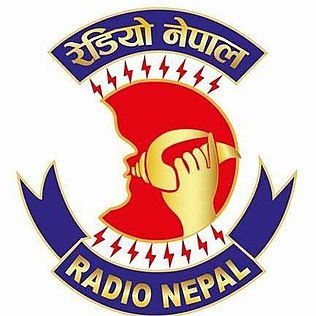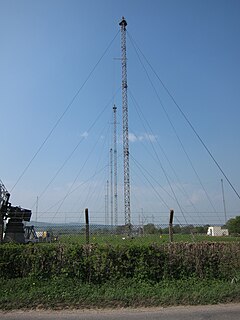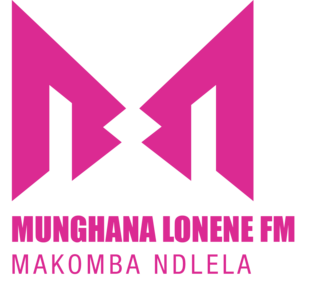Swazi Music Radio (SMR) was a South African radio station broadcasting from Swaziland between 1972 and 1978. It was initially established as Swaziland Commercial Radio but was soon taken over by the South African entrepreneurs Issie and Natie Kirsh as a competitor to LM Radio which broadcast from nearby Mozambique. The studios were based in central Johannesburg and the transmitters were in Sandlane in Swaziland, just across the eastern border of South Africa, not far from the small town of Amsterdam.
Programmes were recorded in Johannesburg and the tapes taken by road to the transmitting station for broadcast the next day. It had been hoped that the medium wave transmission would reach the Johannesburg area during the day, however long distance medium wave propagation in the former Transvaal Province was poor and only really effective at night. Daytime listening was on short wave.
During the years it operated, SMR recruited many of the announcers who had been on LM Radio and SABC stations, among them Gary Edwards, Frank Sanders, John Berks, Darryl Jooste, Leon Fourie, Barry O'Dee and Gordon Hoffman. Another former LM radio announcer George Wayne also returned briefly from Australia to join the station. (Stan Katz, who later went on to become one of South Africa's most prominent broadcasters, joined the station in its early days as a junior programming assistant). Overall, SMR was not commercially successful as it could not compete with the superior technical transmission of Radio 5 (now 5FM) which took over from LM Radio when that station closed in October 1975 and relocated from Mozambique to South Africa.
Operated by the South African Broadcasting Corporation, Radio 5 was heard via local medium wave transmitters in all the major cities in South Africa and also had good short wave coverage. When SMR eventually closed, the studios and transmitters were used to broadcast three ethnic radio services - Radio SR, targeted to the black African market, Radio Paralello 27 which broadcast in Portuguese and Radio Truro aimed at Indian South Africans under the direction of radio veterans Rob Vickers and Zena Watkins. These stations all closed down in the 1980s.
When commercial broadcasting licences were issued in the South African 'homeland' of Bophuthatswana, SMR's directors Natie and Issie Kirsh established Channel 702 which became Radio 702 and then Talk Radio 702. The first Channel 702 transmissions originated from the studios of the original Swazi Music Radio.

Medium wave (MW) is the part of the medium frequency (MF) radio band used mainly for AM radio broadcasting. The spectrum provides about 120 channels with more limited sound quality than FM stations on the FM broadcast band. During the daytime reception is usually limited to more local stations, though this is dependent on the signal conditions and quality of radio receiver used. Improved signal propagation at night allows the reception of much longer distance signals. This can cause increased interference, because on most channels multiple transmitters operate simultaneously worldwide. In addition, amplitude modulation (AM) is often more prone to interference by various electronic devices, especially power supplies and computers. Strong transmitters cover larger areas than on the FM broadcast band but require more energy and longer antennas. Digital modes are possible but have not reached the momentum yet.

Broadcasting is the distribution of audio or video content to a dispersed audience via any electronic mass communications medium, but typically one using the electromagnetic spectrum, in a one-to-many model. Broadcasting began with AM radio, which came into popular use around 1920 with the spread of vacuum tube radio transmitters and receivers. Before this, all forms of electronic communication were one-to-one, with the message intended for a single recipient. The term broadcasting evolved from its use as the agricultural method of sowing seeds in a field by casting them broadly about. It was later adopted for describing the widespread distribution of information by printed materials or by telegraph. Examples applying it to "one-to-many" radio transmissions of an individual station to multiple listeners appeared as early as 1898.

In radio, longwave, long wave or long-wave, and commonly abbreviated LW, refers to parts of the radio spectrum with wavelengths longer than what was originally called the medium-wave broadcasting band. The term is historic, dating from the early 20th century, when the radio spectrum was considered to consist of longwave (LW), medium-wave (MW), and short-wave (SW) radio bands. Most modern radio systems and devices use wavelengths which would then have been considered 'ultra-short'.

Radio broadcasting is transmission of audio (sound), sometimes with related metadata, by radio waves to radio receivers belonging to a public audience. In terrestrial radio broadcasting the radio waves are broadcast by a land-based radio station, while in satellite radio the radio waves are broadcast by a satellite in Earth orbit. To receive the content the listener must have a broadcast radio receiver (radio). Stations are often affiliated with a radio network which provides content in a common radio format, either in broadcast syndication or simulcast or both. Radio stations broadcast with several different types of modulation: AM radio stations transmit in AM, FM radio stations transmit in FM, which are older analog audio standards, while newer digital radio stations transmit in several digital audio standards: DAB, HD radio, DRM. Television broadcasting is a separate service which also uses radio frequencies to broadcast television (video) signals.

Radio Nepal is the state-owned Radio broadcasting organisation of Nepal. It was established 2 April 1951. Radio Nepal airs programs on short wave, medium wave (AM) and FM frequencies.

5FM is a South African FM radio station that follows a Top 40 music format and is owned by the South African Broadcasting Corporation (SABC), South Africa's public broadcaster. The current business manager of PCS combo(5fm and good hope fm) is JD Mostert

The Woofferton transmitting station is owned and operated by Encompass Digital Media, as one of the BBC's assets which were handed over as part of the privatization of World Service distribution and transmission in 1997. It is the last remaining UK shortwave broadcasting site, located at Woofferton, south of Ludlow, Shropshire, England. The large site spreads across into neighbouring Herefordshire.

The BBC Regional Programme was a radio service which was on the air from 9 March 1930 – replacing a number of earlier BBC local stations between 1922 and 1924 – until 1 September 1939 when it was subsumed into the Home Service, two days before the outbreak of World War II.

Deutschlandsender, abbreviated DLS or DS, was one of the longest-established radio broadcasting stations in Germany. The name was used between 1926 and 1993 to denote a number of powerful stations designed to achieve all-Germany coverage.

Munghana Lonene FM is an SABC radio station broadcasting in Tsonga language in South Africa. In Tsonga, "Munghana Lonene" means "a true friend." Munghana Lonene FM is geared to listeners who understand Xitsonga. Munghana Lonene FM is branded as an "infotainment" radio station with a 50% split of music and talk. It offers an environment interactive with its listeners, providing a mixture of news, music, current affairs, talk shows, education, sport, weather and traffic. The music repertoire consists of Jazz, R&B, Kwaito, House, Gospel music and African music.

702 is a commercial FM radio station based in Johannesburg, South Africa, broadcasting on FM 92.7 and FM 106 to the greater Gauteng province. The station is also webcast via its website. It claims to be Johannesburg's number one news and talk station, offering news, sport, business and actuality programming and plenty of phone-in debates.
LM Radio is a radio station based in Maputo, Mozambique. Historically it was a shortwave station broadcasting to South Africa and Rhodesia from Lourenço Marques, the colonial era name of Maputo, hence the name "Lourenço Marques Radio" from 1936 to 1975 when it was shut down by the government of the then newly independent country. In 2010, following political reforms and economic development in Mozambique a new station was launched with the brand "Lifetime Music Radio", trading on the nostalgia of the original LM Radio.

Radio Luxembourg was a multilingual commercial broadcaster in Luxembourg. It is known in most non-English languages as RTL.
RAM FM was an independent English-speaking radio station broadcasting from Ramallah, Palestine.
The Federal Radio Corporation of Nigeria (FRCN) is Nigeria's state radio broadcasting organization. Its subsidiary is the domestic radio network known as Radio Nigeria, with FM stations across the 36 states and Zonal station in the 6 geopolitical zones that broadcast on the SW. According to FRCN it is the largest broadcasting organization in Africa.
Radio and TV broadcasting in Pretoria is supplied via a network of VHF/FM and UHF transmitters and repeaters owned and operated by Sentech - South Africa's state-owned broadcast signal distributor - from four transmitter sites in and around the city. A number of community radio stations operate transmitters from non-Sentech sites.
Nathan "Natie" Kirsh is a South African born, Swazi billionaire businessman. He heads the Kirsh Group, which holds a majority stake in New York state cash and carry operation Jetro Holdings, owner of Restaurant Depot and Jetro Cash & Carry. The Group also holds equity and investments in Australia, Eswatini, the UK, the US, and Israel.
Primedia is a South African media group, headquartered in Sandton, Johannesburg.
David Gresham is a South African independent record producer, publisher, promoter, and radio & television personality. He is best known for his career on SABC's Springbok Radio show, South Africa's Top 20 and on SABC TV's, Pop Shop. He owns David Gresham Entertainment Group. His career, starting in the 1960s and has spanned five decades.
John Berks was a well-known South African radio presenter. Known for his role as a breakfast presenter on Radio 702 in Johannesburg. His broadcast career covered many countries in Southern Africa and stretched from 1964 until 2001.